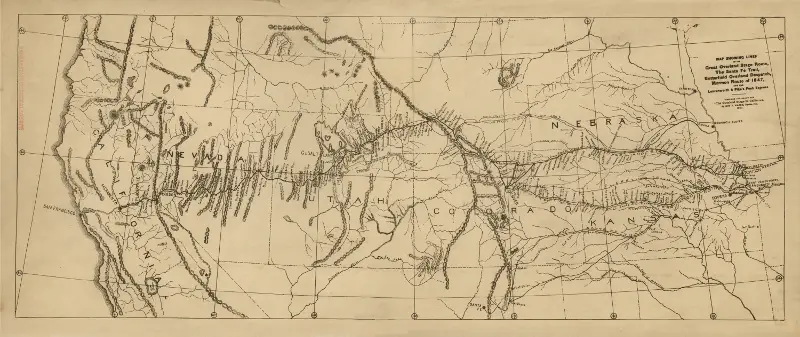The Overland Trail was one of a number of routes westward for American settlers and mail delivery during the 19th Century. The brainchild of "Stagecoach King" Holladay, the Overland Trail started in Kansas and ended in Wyoming and functioned as a mail delivery route for several years during the 1860s. It functioned as a successor to the Butterfield Overland Mail Company. 

Holladay was a businessman who bought a failing mail company, the Central Overland Company and Pikes Peak Express, in 1862 and set about making improvements. He replaced the horses and wagons and coaches and hired new people to run the company, not only to help deliver the mail but also to run the various stages along the 1,100 miles of trail. In essence, Holladay's efforts were the successor to the Pony Express. He bought new Concord coaches, considered by many to be the finest stagecoaches ever to take people and things west. He added new stations to the route. Holladay also gave the company a new name, the Overland Mail and Express Company. The Overland Trail in part followed existing ways west, including the Cherokee Trail, the Mormon Trail, the Oregon Trail, and the Santa Fe Trail. These other trails had been the routes of choice for many people heading west for a couple of decades by this time. However, the increasing numbers of settlers traveling through territory still owned by Native Americans was increasing tensions between those who lived along the trail and those who were just passing through. Holladay looked to avoid such tensions by choosing a slightly more southern route for his mail delivery plan. As well, the Civil War had begun in 1861, and the Union Army had signaled a need for U.S. Army soldiers who had been stationed in the West to travel eastward to join the war effort there. 
The Overland Trail began in Kansas, at the town of Atchison, and ran westward in that state and a bit north and then west in Nebraska, along the North Platte River. Crossing Nebraska, the Overland Trail reached Julesburg, Colo, where it followed the South Platte River for a time through the rest of Colorado and into Wyoming, going through (Jim) Bridger's Pass before ending up at Fort Bridger. From there, travelers veered onto other existing trails if their destination was further west. Some of the important stops along the Overland Trail were these:
The Overland Trail proved very popular with travelers. Some sources say that at its peak from 1862 to 1868, annual travel numbered 20,000 people. Holladay had a contract from the U.S. Government to deliver mail and other goods and even settlers along the Overland Trail from 1862 to 1868. Travel along the Overland Trail was not immune to the kind of violence that plagued more northern routes like the Oregon Trail. Tensions between U.S. Army and Native Americans in the west had increased again, and Native American attacks on Overland Trail wagons and coaches increased dramatically in 1864 and 1865. In the latter year, the town of Julesburg, Colo., was razed. The Civil War had ended in 1865, and the U.S. had turned in earnest to the building of a transcontinental railroad. Holladay had installed a telegraph line along his route in 1863. In the same way that the telegraph helped engineer the extinction of the Pony Express, the arrival of the coast-to-coast railroad rendered less necessary the Overland Trail. The Golden Spike was driven in 1869. Holladay, seeing the writing on the wall, had sold out three years before, to Wells Fargo, at a purchase prise of $1.8 million. The last stagecoach on the Overland Trail reached Denver in 1870. Little remains of the Overland Trail, except for landmarks that have been preserved and museums that have been built to commemorate the route. The present-day interstate highway I-80 roughly runs along the route in part, as do other state and federal highways, as does the railroad. Some details of life along the trail, including a detailed description of travel in a Concord coach, survive in Roughing It, a book by Mark Twain. |
|
Social Studies for Kids
copyright 2002–2024
David White




